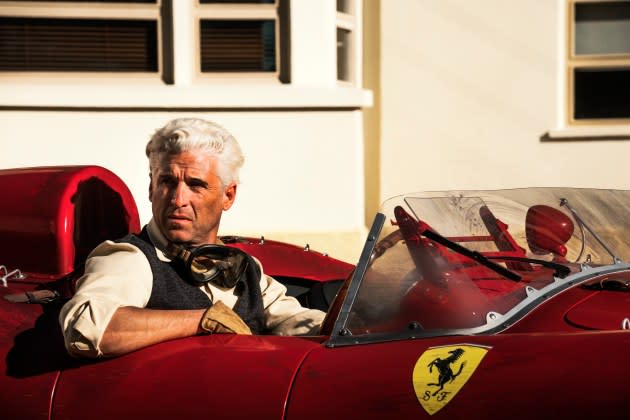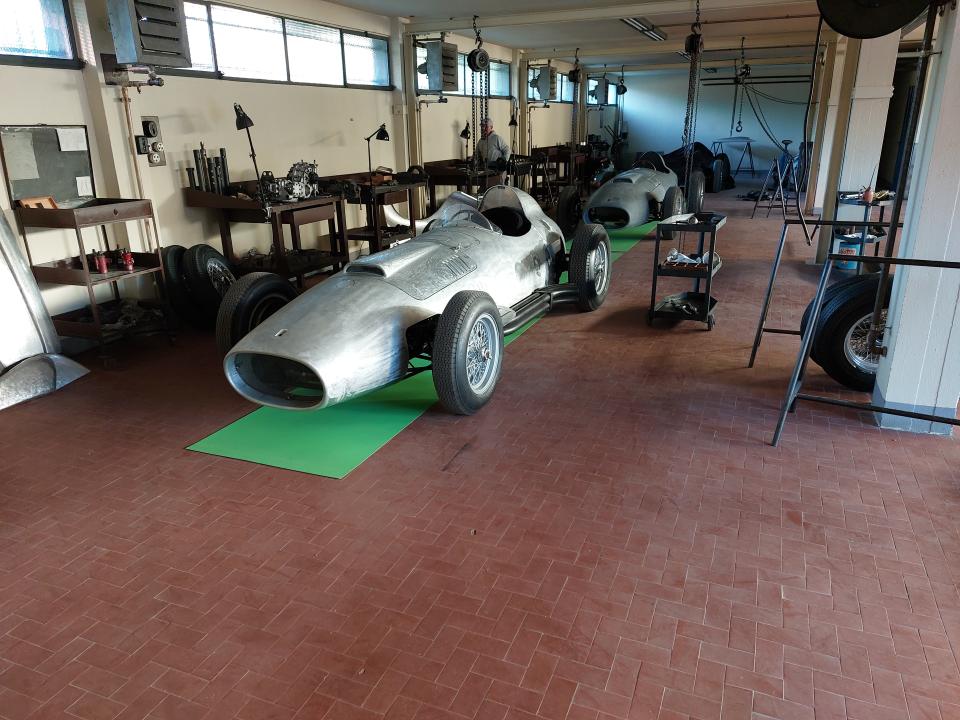How ‘Ferrari’ Sourced $70 Million Vintage Cars to Create Authentic Racing Sequences

Michael Mann’s 12th film, “Ferrari” was always meant to do more than catalog the achievements of a legendary racing team and its automotive parent. Even so, its story climaxes with a pivotal race in the brand’s history — the 1957 Mille Miglia — that required a tremendous amount of work, and more than a little luck to recreate. The fact that the sporting event took place more than 60 years ago meant that some vehicles would just be very hard to source, while others were impossible. But picture vehicle supervisor Danny Triphook says that as the production reached out to members of a worldwide network of auto collectors who they hoped would loan their vehicles to use in the sequence, his collaborators’ confidence was buoyed after unexpectedly obtaining access to car they had initially lumped in the latter category.
“We thought we were not going to be able to find the car that won the Mille Miglia, the one driven by Piero Taruffi,” says Triphook. “But what happened is that whilst talking to one of the owners, he said, ‘What do you think about having the actual winning car of the film on the film? A friend of mine owns it, and I can just speak to him and we can have it.’”
More from Variety
Triphook has worked since 2015 to obtain and transport picture vehicles to far-flung locations on everything from “Spectre” to “Tenet.” On “Ferrari,” he was responsible for a total of 393: “that’s everything — cars, trains, motorcycles, trucks, anything, you name it,” he says. With cars like Taruffi’s Ferrari 315 S and the others featured in the race, Triphook says he was essentially convincing people to let them risk damaging what was in some cases a multi-million-dollar conveyance in order for Mann to achieve a few extra minutes of historical verisimilitude.
“The most complicated part of it was trying to convince the owners, to tell them, ‘Hey, we’re going to use the car at 200 kilometers an hour and it’s Italian roads, and it’s going to be driven by a stunt driver or an actor,’” Triphook recalls. Thankfully, the filmmaker’s pedigree greased a few of those wheels. “A lot of the people were actually fans of Michael, so [they] just said yes to my questions without even questioning what we were going to be doing.”
He says that a lot of collectors ended up joining simply because they learned their friends already had done so. “Once some important collectors in Europe said yes, the other ones just wanted to follow — ‘I’m not going to miss this’,” he remembers. “Some of the cars we had there, they [cost] $10, 20, 40, 70 million dollars, and we were using them on set — you can imagine the insurance policy for those.”
As costly as it might have been, Triphook says that the price tag was worth it when he saw the look on Mann’s face. “I turned up on set with 40 vehicles — I don’t know how many million dollars we had that day on that square,” he remembers. “But it was such a strong display of machines that Michael got out of his van and he didn’t know where to look. And he made us all stop all the crew, and he documented every single car in that square for half an hour with his camera team.”
For the vehicles they couldn’t borrow from ultra-wealthy collectors, “Ferrari” turned to Rita Campana, whose family company owns and operates the oldest body shop in Modena. Armed with Campana’s 76 years of experience, she led the process of developing believable replicas of the cars raced by Team Ferrari in the Mille Miglia. “We could build them like we could have done with an original car,” Campana says. “In three months and a half basically, we built three Ferrari 335 S. Two Ferrari 315 S. Two Ferrari 801 F1, and two Maserati 450 S.”

She says that the 801 was the most difficult one to build because it’s one of the vehicles that no longer exists. “We had to scan a small model, and then rescale it creating the right proportions,” Campana says. Though some of the cars more or less had to be built in the same way they were back in 1957, modern technology accelerated the construction of others. “I remember when my grandfather did some restorations on the real cars, he only had the drawing on a paper,” she remembers. “Having a 3D model from which we could create a wooden model, we could beat the metal on the wooden model to save time.”
In some cases, choosing which materials to make the replicas from was decided by what they would be used for in the film. “We had to create some of the cars in aluminum because they had to be crashed,” she reveals. “Michael wanted to see the real behavior of the material like in a real crash.” Their approach to the crashed cars was decidedly old-school. “We took a chassis and we stretched it. We hammered the metal in a hard way. We crashed the mirror.”
Meanwhile, there’s a joke in the film where Taruffi complains that his car lacks a crucial amenity: an ash tray for his cigarettes. Campana says they made some minor adjustments to accommodate each actor or driver’s specific needs, but none that would undercut Mann’s commitment to authenticity. “The biggest change when you have to think about one driver or another is the seat and the distance of the steering wheel,” Campana says.
“And in the fiberglass cars, we had a little border on the doors that was difficult for the drivers to be there, so we just changed the dimension of that border to let them move easier.” The final consideration that Campana and her team had to accommodate was how the cars were going to be filmed — and from where. “We had to weld some brackets to the chassis, to make the holes in the body so that the camera guys could attach it to the cars,” she says.
That decision to compromise the beauty of some of the models in order to more viscerally capture the race suited cinematographer Erik Messerschmidt just fine. “We were not going out of our way to glamorize the car, ever,” Messerschmidt says. “We were trying to shy away from that concept and focus on the other side of it, the visceral, high energy, dramatic portion of the movie. The beauty would take care of itself.”
The Oscar-winning director of photography says that like Triphook and Campana did with the cars themselves, he researched how the races were filmed back when they actually happened. “The stabilized camera is almost an anachronistic concept,” he says. “When you look at the archival footage of this period, you feel the road noise, you see the shape, you see the energy of it. Michael wanted that to carry through.”
In particular, Campana’s work with the brackets made it possible for them to capture footage that wouldn’t have been possible with an original car. “What happens a lot, and particularly with vintage cars, is these are either mono-bodies or they’re a single body panel that is meticulously welded to portions of frame. They’re very difficult to mount cameras to, and you have to be quite delicate with them,” Messerschmidt says. “We didn’t have that issue because we could design them.
“We did a lot of testing with the stunt team, mounting cameras, looking at the weight distribution, and whether or not that would affect the performance of the car,” he continues. “The entire essence of it was really trying to make sure that the audience experiences it as real and as authentic as possible.”
Along with being an “amateur mechanic,” Messerschmidt says his work on films like JD Dillard’s “Devotion,” where he mounted cameras to airplanes traveling at 300 knots, helped him anticipate how to shoot “Ferrari.” “There is a diminishing return at a certain point, depending on your lensing, before the audience no longer feels speed,” he observes. “There’s to some degree a sweet spot between making sure that it accurately represents the conditions of how the car would behave, but also against safety, and also simply just not telling the difference between 80 and 100 miles an hour.”
In addition to designing the specific shots that Mann wanted, Messerschmidt was also armed with a handful of visual tricks to amplify the intensity of the races. “In profile, you go 50, 60 miles an hour, and it looks like you’re going 100 just because of the motion blur in the background,” he explains. “Also, the focal length you’re using has a lot to do with it. A wider lens that’s close to the ground, where we call it ground rush, can sell speed extremely well. The higher the camera and the longer the lens, the slower the car tends to look.”
“The wonderful thing about digital photography is you see it immediately, so you’re able to make adjustments quickly,” he adds. “And to say that Michael is car literate would be an understatement, so he knows exactly what he’s trying to achieve — and generally how to solve it.”
Ultimately, Messerschmidt and Mann combined these boilerplate cinematic techniques with cutting-edge technology as a way to pay homage to, and also propel forward, automotive racing’s long history with visual storytelling. He says, “conversations Michael and I had were about the cinema grammar of how referential to be to the modern techniques of visual storytelling and assembly, and when to step back and let it be visceral and loud — and to some degree disorienting.” Even so, the “Ferrari” cinematographer welcomed the pressure to get that balance right.
“I’ve said it before, but amenable directors don’t make good movies,” Messerschmidt says. “Michael is pushing everybody all the time, and we’re all pushing each other and trying to achieve the best we can. But the movie should be challenging. You should worry about it when it’s easy.”
Best of Variety
'House of the Dragon': Every Character and What You Need to Know About the 'Game of Thrones' Prequel
25 Groundbreaking Female Directors: From Alice Guy to Chloé Zhao
Sign up for Variety’s Newsletter. For the latest news, follow us on Facebook, Twitter, and Instagram.


